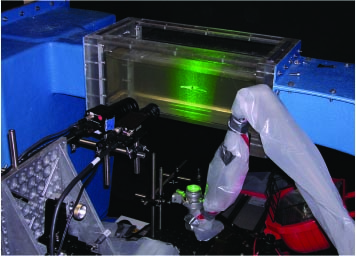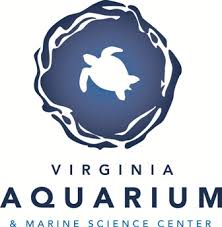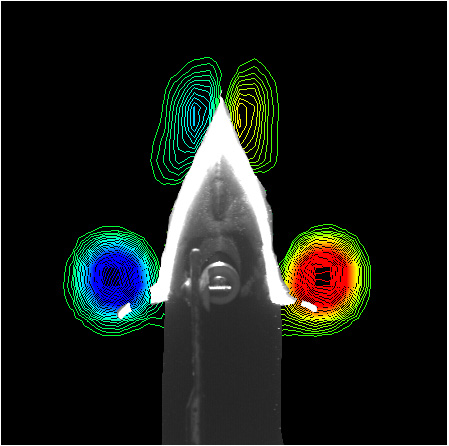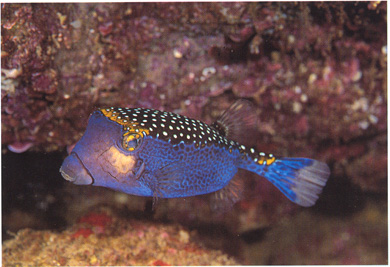Hydrodynamic and Muscular Mechanical Investigation of Maneuverability in Cephalopods throughout Ontogeny
Collaborators: Drs. Paul S. Krueger (Southern Methodist University) and Joe T. Thompson (Franklin and Marshall College)
Maneuvering in the aquatic environment is a significant component of routine swimming, with proficient maneuvering being essential for predator avoidance, prey capture, and navigation. Despite its importance, understanding of the biomechanics of maneuvering behaviors is limited. Therefore, for this project, our team is investigating maneuvering performance in three morphologically distinct species of cephalopods. The investigation explores three broad questions: (1) how are the fins, arms, and funnel-jet complex used in concert to maximize turning performance in adult cephalopods; (2) do the relative importance of turning rate and turning radius change over ontogeny and are fewer turning modes observed in young cephalopods; and (3) do fin, arm, and funnel musculoskeletal mechanics change over ontogeny and are such changes associated with differences in maneuvering? These questions will be addressed by collecting measurements of 3D high-speed kinematics and 2D/3D hydrodynamics of wake flows; performing mathematical analyses to quantitatively identify and categorize turning patterns; and measuring both the dynamic passive and active length-force relationship and maximum shortening velocity of muscle fibers that drive the movements used during turning and jet vectoring.
Some of the key findings of this work related to this project are described in the following papers:
Ganley, A.M., Krueger, P.S., and Bartol, I.K. (2023). Faster is not always better: turning performance trade-offs in the inshore squids Doryteuthis pealeii and Illex illecebrosus. J. Exp. Mar. Biol. Ecol. 565:151913 <pdf>
Bartol, I.K., Ganley, A.M., Tumminelli, A.N., Bartol, S.M., Thompson, J.T., and Krueger, P.S. (2023). Turning performance and wake dynamics of neritic squids. Mar. Biol. 170:73 https://doi.org/10.1007/s00227-023-04214-3<pdf>
Bartol, I.K., Ganley, A.M., Tumminelli, A.N., Krueger, P.S., and Thompson, J.T. (2022). Vectored jets power arms-first and tail-first turns differently in brief squid with assistance from fins and keeled arms. J. Exp. Biol. 224, doi:10.1242/jeb.244151<pdf
York, C.A., Bartol, I.K., Krueger, P.S., Thompson, J.T. (2020). Squids use multiple escape jets throughout ontogeny. Biology Open 9, bio054585. doi:10.1242/bio.054585<pdf>
Jastrebsky, R.A., Bartol, I.K., and Krueger, P.S. (2017). Turning performance of brief squid Lolliguncula brevis during attacks on shrimp and fish. J. Exp. Biol. 220: 908-919 <pdf>
Jastrebsky, R.A., Bartol, I.K., and Krueger, P.S. (2016). Turning performance in squid and cuttlefish: unique dual mode, muscular hydrostatic systems. J. Exp. Biol. 219: 1317-1326 <pdf>
FUNDING: This research is supported by the National Science Foundation.
Volumetric quantification of flows from multi-propulsor systems
Collaborators: Drs. Paul S. Krueger (Southern Methodist University) and Joe T. Thompson (Franklin and Marshall College)
For this project, we are developing a novel 3D approach for identifying gaits in rectilinear swimming using (i) volumetric (3D) defocusing digital particle tracking velocimetry (DDPTV) of the complete wake of swimming squid; (ii) proper orthogonal decomposition (POD) and critical point analysis to quantitatively identify fundamentally distinct kinematic motions and wake signatures, respectively; and (iii) propulsive performance metrics (e.g., propulsive efficiency) derived from DDPTV measurements. Several important results have emerged from our work including: (i) the jet is the primary propulsive mechanism for most rectilinear swimming with the fins playing reduced propulsive but significant stabilizing and lift-generating roles; (ii) isolated and interconnected vortex rings are prominent fin/jet wake features with isolated vortex ring wakes having higher propulsive efficiency than longer wakes; (iii) fin thrust and fin wake complexity are greater during arms-first than tail-first swimming but there is no difference in propulsive efficiency between the two modes; and (iv) more gaits, i.e., distinct kinematic and hydrodynamic patterns with associated performance benefits, are present in squid than previously thought.
Some of the key findings of this work related to this project are described in the following papers:
Bartol, I.K., Krueger, P.S., Jastrebsky, R.A, Hooman, F., and Thompson, J.T. (2016). Volumetric flow imaging reveals the importance of vortex ring formation in squid swimming tail-first and arms-first. J. Exp. Biol. 219: 392-403. <pdf>
Bartol, I.K., Krueger, P.S., York, C.A., and Thompson, J.T. (2018). New approaches for assessing fin motions in squid: coupling proper orthogonal decomposition (POD) with volumetric particle tracking velocimetry. J. Exp. Biol. doi: 10.1242/jeb.176750v <pdf>
FUNDING: This research is supported by the National Science Foundation.
Ontogenetic jet changes in swimming squid
Collaborators: Drs. Paul S. Krueger (Southern Methodist University) and Joe T. Thompson (Franklin and Marshall College)
Pulsed jetting is used by squids of remarkably different sizes, from hatchlings that are only a few millimeters in length to adults that may grow as large as 18 m. Over this wide size range, the physics of fluids plays an important role in the evolution of various jet features (e.g., characteristic vortices known as vortex rings) that are central to propulsive swimming performance. This collaborative project investigated how fluid mechanical constraints shape swimming strategies and muscular mechanics in squid of different life history stages, with the ultimate goal of assessing how propulsive jet efficiency changes with size. My component of the project was to investigate swimming mechanics of squids throughout ontogeny. This was accomplished by studying squid swimming in water seeded with light-reflective particles in custom-built chambers or water tunnels. As particle-laden water was expelled from the funnel, it was illuminated with lasers and videotaped so that the jet velocity could be determined using a technique known as digital particle image velocimetry (DPIV). These DPIV data provided direct measurements of jet features and propulsive efficiency. Multiple video cameras positioned on a motorized rail system were used to collect high-resolution images of the mantle and funnel as the squids swam, providing valuable data on swimming behavior.
Some of the key findings of this work related to my component of the project are described in the following papers:
Bartol, I. K., Krueger, P. S., Stewart, W. J. and Thompson, J. T. (2009). Hydrodynamics of pulsed jetting in juvenile and adult brief squid Lolliguncula brevis: evidence of multiple jet ‘modes’ and their implications for propulsive efficiency. J. Exp. Biol. 212, 1889-1903 <pdf>
Bartol, I. K., Krueger, P. S., Stewart, W. J. and Thompson, J. T. (2009). Pulsed jet dynamics of squid hatchlings at intermediate Reynolds numbers. J. Exp. Biol.212,1506-1518 <pdf>
Krueger, P.S., A.A. Moslemi, J.T. Tyler, I.K. Bartol, and W.J. Stewart. (2008). Vortex rings in bio-inspired and biological jet propulsion. Adv. Sci. Tech. 58: 237-246. <pdf>
Bartol, I.K., P.S. Krueger, J.T. Thompson, and W.J. Stewart. (2008). Swimming dynamics and propulsive efficiency of squids throughout ontogeny. Int. Comp. Biol. 48, 720-733. <pdf>
FUNDING: This research was supported by the National Science Foundation and the Jeffress Memorial Trust.
Role of fins in propulsion of squid
Collaborators: Drs. Paul S. Krueger (Southern Methodist University), Joe T. Thompson (Franklin and Marshall College), and William Stewart (U. of Florida)
Although there is considerable diversity in fin form and function in squids, the locomotive role of the fins is not well understood. While the jet is the foundation of the locomotive system for most squids, the fins also play important roles in swimming, providing thrust, lift, and dynamic stability. In this project, several high-speed video cameras were used to record the kinematics of fin motion in the brief squid Lolliguncula brevis, and DPIV was used to study flows around the fins as they undulate/oscillate over a range of swimming speeds.
Some of the key findings of this work are included in the following papers:
Bartol, I.K., P.S. Krueger, J.T. Thompson, and W.J. Stewart. (2008). Swimming dynamics and propulsive efficiency of squids throughout ontogeny. Int. Comp. Biol.48, 720-733.<pdf>
Stewart, W. J., Bartol, I. K., and Krueger, P. S. (2009). Hydrodynamic fin function of brief squid Lolliguncula brevis. J. Exp. Biol. 213, 2009-2024. <pdf>
FUNDING: This research was supported by the National Science Foundation and the Jeffress Memorial Trust.
Hearing capabilities of loggerhead sea turtles (Caretta caretta) throughout ontogeny
Collaborators: Dr. Soraya Moein Bartol (Virginia Wesleyan College)
Sea turtles reside in different acoustic environments with each life history stage and may have different hearing capacity throughout ontogeny. For this study, we are using electrophysiological and behavioral techniques to study hearing capabilities of sea turtles throughout ontogeny. All experiments are being conducted at the National Oceanic and Atmospheric Administration (NOAA) Fisheries Galveston Laboratory, TX. The data collected for this project will serve as an integral component of future assessment plans that address potential impacts of sound on sea turtles.
Some of the key findings of this work are included in the following papers:
Lavender, A.L., Bartol, S.M., and Bartol, I.K. (2014). Ontogenetic investigation of underwater hearing capabilities in loggerhead sea turtles Caretta caretta using a dual testing approach. J. Exp. Biol. 217: 2580-2589. pdf
Lavender, A. L., S. M. Bartol, and I. K. Bartol. (2012). Hearing capabilities of loggerhead sea turtles (Caretta caretta) throughout ontogeny. In The Effects of Noise on Aquatic Life, (ed. A. N. Popper and A. Hawkins), Advances in Experimental Medicine and Biology Series 703, pp. 89-92. New York: Springer.
FUNDING: This project is funded by the Joint Industry Program of the International Association of Oil and Gas Producers.
Swimming mechanics of sea turtles
Role of the carapace and fins of boxfishes in stability and maneuverability
Collaborators: Dr. Malcolm Gordon (UCLA), Dr. Mory Gharib (Caltech), Dr. Paul Webb (U. of Michigan), Dr. Daniel Weihs (Technion)

The key findings of this work are described in the following papers:
Bartol, I.K., M.S. Gordon, P.W. Webb, D. Weihs, M. Gharib. (2008). Evidence of self-correcting spiral flows in swimming boxfishes. Bioinsp. Biomim. 3:1-7. <pdf>
Bartol, I.K., M. Gharib, P.W. Webb, D. Weihs, and M.S. Gordon. (2005). Body-induced vortical flows: a common mechanism for self-corrective trimming control in boxfishes J. Exp. Biol. 208: 327-344. <pdf>
Bartol, I.K., M. Gharib, D. Weihs, P.W. Webb, J.R. Hove, and M. S. Gordon. (2003). Hydrodynamic stability of swimming in ostraciid fishes: role of the carapace in the smooth trunkfish Lactophrys triqueter (Teleostei: Ostraciidae). J. Exp. Biol. 206: 725-744. <pdf>
Bartol, I.K., M.S. Gordon, M. Gharib, J. Hove, P.W. Webb, and D. Weihs. (2002). Flow patterns around the carapaces of rigid-bodied, multi-propulsor boxfishes (Teleostei: Ostraciidae). Int. Comp. Biol. 42: 971-980.
FUNDING: This work was funded by the Office of Naval Research.
















